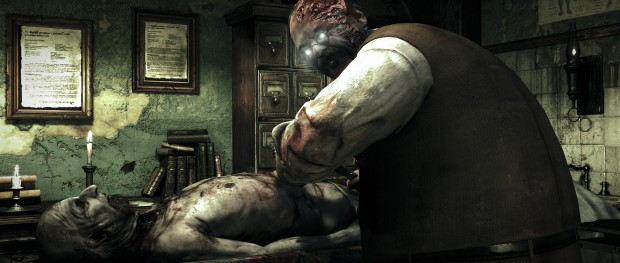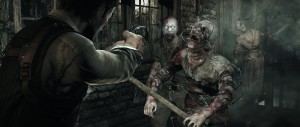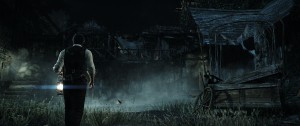The Evil Within Review (PS4)
- Updated: 27th Oct, 2014

The Evil Within is a bit like a survival horror greatest hits collection. You’ve got slow, expertly-paced moments of suspense, plenty of disturbing imagery and violent gunplay that kicks like a mule, all lovingly daubed with a thick layer of grime and clotted blood that chokes every scene to great effect.
It attempts to harness many staples of the genre, yet it excels at few of them for the duration. What it achieves in brilliantly loathsome creature and aesthetic design, well-realised locales and moments of genuinely superb action, it loses by delivering mechanics that feel scattershot by execution.
Sneaking sections are part of the overarching problem as stealth – the player is told early on, is a key tactic for overcoming packs of savage freaks on the prowl. You can even hide under beds and inside cupboards to avoid fighting altogether, but this rarely proves useful or necessary in latter stages.
In fact, for every step Shinji Mikami takes away from shooter tropes, the game seems intent on pushing you into locked areas full of enemies – shoot them all to proceed, you know the drill by now. The finished product feels fragmented throughout, and certainly won’t feel scary to genre veterans.
Granted, ammo is scarce on higher difficulty tiers, and when clips run dry you’ll find yourself hitting the crouch prompt to stay hidden, while hurling bottles to create distractions like you’re playing The Last of Us. The real pain here is inability to flatten onto cover and peer round corners, forcing you to carefully angle the camera instead.
That reeks of poor, archaic execution, and overlooks third-person advancements of the last decade. This game feels old, but in those brilliant moments where The Evil Within steps into innovative territory, you’ll start to see slivers of genius rise to the surface. The quality almost routinely dips after these peaks, as if the project is trapped inside its own old-school heritage, fighting tooth and nail to shake free but ultimately being clubbed back into submission by poor sign-posting, cheap one-hit deaths, and unclear demands of the player.
Light at the end of the gore-filled tunnel
After all of these complaints, Tango Gameworks still manages to present something serviceable that is destined to go down as a cherished hit, and that’s largely because the good outweighs the bad. While gunplay is discouraged, bland every-cop Sebastian Castellanos does pack a chunky arsenal capable of producing brutal, exploding head shots and mayhem with a few trigger-pulls.
 The pistol is weak – used largely to create meagre space among crowds, while the shotgun, magnum and sniper rifle are real powerhouses. Top prize goes to the Agony Bolt crossbow, which offers a range of shot types that can freeze, shock, blind and blow up foes. You can also craft extra bolts by disarming traps for scrap in what is a solid bit of risk-reward.
The pistol is weak – used largely to create meagre space among crowds, while the shotgun, magnum and sniper rifle are real powerhouses. Top prize goes to the Agony Bolt crossbow, which offers a range of shot types that can freeze, shock, blind and blow up foes. You can also craft extra bolts by disarming traps for scrap in what is a solid bit of risk-reward.
Successfully neutralise a bomb and you’ll get more parts for ammo. Fail while on low health and you’re dead. It’s wonderfully tense and a subtle master stroke from the developer. You’ll need all the firepower you can muster, especially against the game’s hulking and truly intimidating bosses. While a few of these encounters infuriate through instant deaths, they are mostly effective, claustrophobic battles.
As cumbersome as many of these big encounters are, they are also among the game’s stand-out victories. Seeing a huge, lumbering monstrosity comprised of several puss-dripping limbs is enough to regain your attention, and you’ll scramble around in a blind panic searching for all the ammo you can muster. If the game’s intent is to create tension and fear, then these are the moments that fit the bill. You always feel weak, like mere prey for creatures that stalk the night.
A real, chilling sense of place
Mikami’s biggest win is perhaps his unwavering vision, which has resulted in some truly despicable enemies and murky surroundings. Dusty crypts feel alive with grot as the player evades repulsive creatures, only to be whisked away to encroaching corridors comprised of giant cracked mannequin heads, before getting spewed out into a striking field of swaying sunflowers on a calm summer’s eve.
This is where Mikami’s talent for throwing new things at players works best, and this was a technique employed to great effect in his sorely undersold shooter Vanquish. Progression is also solid, and sees players using gathered jars of brain matter to increase their stats. Whether you’re increasing your sprint duration, reload time, or any number of things, the effect is tangible, and that is no small feat indeed.
 The longer you spend with The Evil Within, you’ll probably start to warm to its awkward, trying ways, and that’s maybe down to culture shock more than anything else. After all, since Resident Evil 4 came and went, we’ve all been spoiled by a decade of blatant sign-posting, mechanics that lead intrusively by hand, and auto-saves that dilute tension at every juncture.
The longer you spend with The Evil Within, you’ll probably start to warm to its awkward, trying ways, and that’s maybe down to culture shock more than anything else. After all, since Resident Evil 4 came and went, we’ve all been spoiled by a decade of blatant sign-posting, mechanics that lead intrusively by hand, and auto-saves that dilute tension at every juncture.
Going back to the days of manual save points and constantly feeling like you’re on the backfoot might feel unpalatable at first, but that is exactly what made the survival horror originals such punishing, positively stressful slogs. That spirit remains intact here, and many gamers will surely view that as a big win.
Everyone else should consider if they still have the patience to be thrown into a rusty grinder for well over ten hours of crushingly savage, old-school pain with little in the way of reprieve. It’s a crucial factor. Ponder it.


Follow Us!